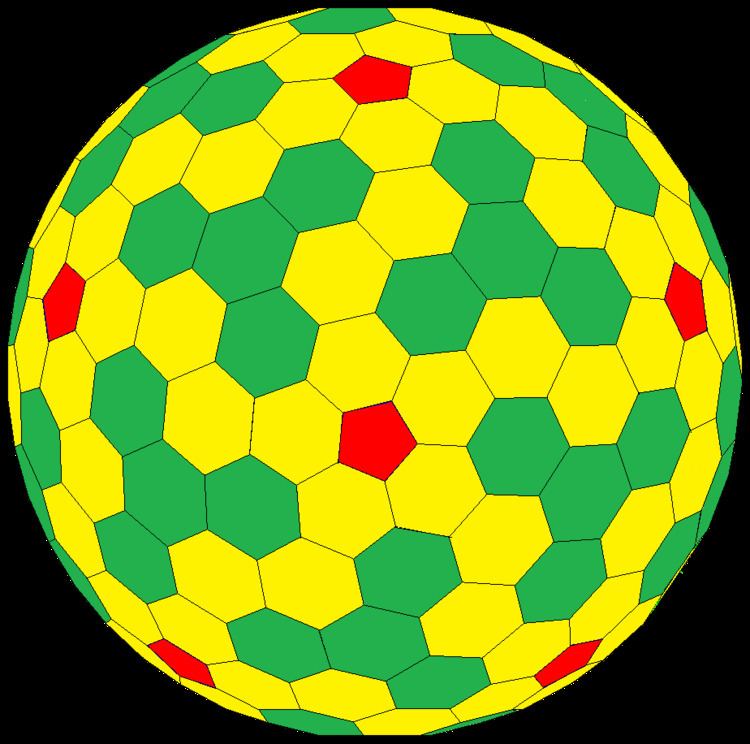 | ||
A Goldberg polyhedron is a convex polyhedron made from hexagons and pentagons. They were first described by Michael Goldberg (1902–1990) in 1937. They are defined by three properties: each face is either a pentagon or hexagon, exactly three faces meet at each vertex, they have rotational icosahedral symmetry. They are not necessarily mirror-symmetric; e.g. GP(5,3) and GP(3,5) are enantiomorphs of each other. A consequence of Euler's polyhedron formula is that there will be exactly twelve pentagons.
Contents
Icosahedral symmetry ensures that the pentagons are always regular, although many of the hexagons may not be. Typically all of the vertices lie on a sphere, but they can also be computed as equilateral.
It is a dual polyhedron of a geodesic sphere, with all triangle faces and 6 triangles per vertex, except for 12 vertices with 5 triangles.
Simple examples of Goldberg polyhedra include the dodecahedron and truncated icosahedron. Other forms can be described by taking a chess knight move from one pentagon to the next: first take m steps in one direction, then turn 60° to the left and take n steps. Such a polyhedron is denoted GP(m,n). A dodecahedron is GP(1,0) and a truncated icosahedron is GP(1,1).
A similar technique can be applied to construct polyhedra with tetrahedral symmetry and octahedral symmetry. These polyhedra will have triangles or squares rather than pentagons. These variations are given Roman numeral subscripts: GPIII(n,m), GPIV(n,m), and GPV(n,m).
Elements
The number of vertices, edges, and faces of GP(m,n) can be computed from m and n, with T = m2 + mn + n2 = (m + n)2 − mn, depending on one of three symmetry systems:
Construction
Most Goldberg polyhedra can be constructed using Conway polyhedron notation starting with (T)etrahedron, (C)ube, and (D)odecahedron seeds. The chamfer operator, c, replaces all edges by hexagons, transforming GP(m,n) to GP(2m,2n), with a T multiplier of 4. The truncated kis operator, y=tk, generates GP(3,0), transforming GP(m,n) to GP(3m,3n), with a T multiplier of 9.
For class 2 forms, the dual kis operator, z=dk, transforms GP(a,0) into GP(a,a), with a T multiplier of 3. For class 3 forms, the whirl operator, w, generates GP(2,1), with a T multiplier of 7. A clockwise and counterclockwise whirl generator, ww=wrw generates GP(7,0) in class 1. In general, a whirl can transform a GP(a,b) into GP(a+3b,2a-b) for a>b and the same chiral direction. If chiral directions are reversed, GP(a,b) becomes GP(2a+3b,a-2b) if a>=2b, and GP(3a+b,2b-a) if a<2b.
